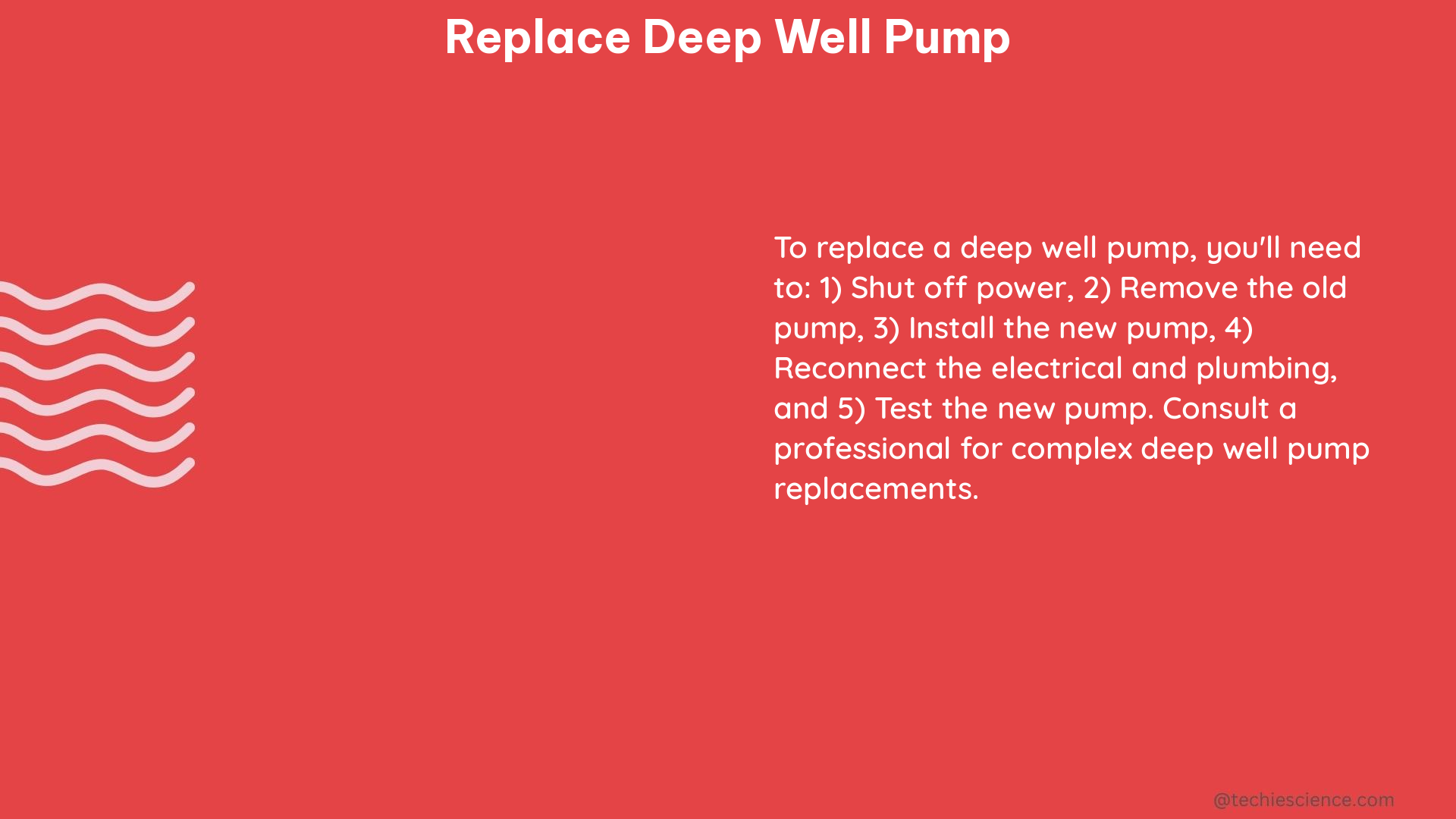Replacing a deep well pump is a critical task that requires careful consideration of various factors, including the type of pump, the depth of the well, and the condition of the well casing or piping. This comprehensive guide will provide you with the technical details and specific information you need to successfully replace your deep well pump.
Understanding Deep Well Pumps
Deep well pumps are designed to operate at depths of 25 feet or more, with some models capable of reaching depths of up to 400 feet. These pumps are typically submersible, meaning they are submerged in the water within the well. The two most common types of deep well pumps are:
-
Submersible Well Pumps: These pumps are installed at the bottom of the well and are submerged in the water. They are known for their efficiency and reliability, and can handle depths of up to 400 feet.
-
Jet Well Pumps: These pumps are installed above the well and use a venturi effect to draw water from the well. They are typically less expensive than submersible pumps but are limited to shallower well depths, usually up to 25 feet.
Factors to Consider When Replacing a Deep Well Pump

When replacing a deep well pump, there are several critical factors to consider:
1. Well Depth
The depth of your well is a crucial factor in determining the type of pump you will need. Submersible pumps are typically used for wells deeper than 25 feet, while jet pumps are better suited for shallower wells.
2. Pump Capacity
The capacity of the new pump should match the water demand of your household or irrigation system. Factors such as the number of bathrooms, the size of your property, and the irrigation needs will all influence the required pump capacity. As a general guideline, a 1/2 HP pump can handle a well depth of up to 100 feet and provide water for a typical 3-bedroom home, while a 3/4 HP pump can handle depths up to 200 feet and larger homes or irrigation systems.
3. Pump Type
As mentioned earlier, the two main types of deep well pumps are submersible and jet pumps. Submersible pumps are more efficient and can handle greater depths, but they are also more expensive. Jet pumps are less expensive but are limited to shallower well depths.
4. Pump Efficiency
The efficiency of the pump is an important consideration, as it can impact your energy costs. Look for pumps with high energy efficiency ratings, such as those with permanent magnet synchronous motors (PMSM) or variable frequency drives (VFD), which can significantly reduce energy consumption.
5. Well Casing and Piping Condition
Before replacing the pump, it’s essential to inspect the well casing and piping for any damage or wear. If the casing or piping is in poor condition, it may need to be repaired or replaced, which can add to the overall cost of the project.
6. Safety Considerations
Replacing a deep well pump can be a hazardous task, as it involves working with electrical systems and potentially hazardous materials. It’s crucial to follow all necessary safety precautions, including shutting off power to the well, wearing appropriate personal protective equipment (PPE), and properly sanitizing the well after the replacement is complete.
Estimated Costs for Replacing a Deep Well Pump
The cost of replacing a deep well pump can vary widely, depending on the factors mentioned above. According to HomeAdvisor, the average cost to replace a well pump is between $900 and $3,000. Here’s a more detailed breakdown of the costs:
| Pump Type | Cost Range |
|---|---|
| Jet Well Pump | $200 – $700 |
| Submersible Well Pump | $200 – $1,200 |
| Solar Well Pump | Around $2,000 |
In addition to the cost of the pump itself, there may be additional expenses for pipework, labor, and any necessary well casing or piping repairs. The total cost of installing a new submersible well pump and pipework can range from $2,000 to $4,000.
Conclusion
Replacing a deep well pump is a complex task that requires careful consideration of various technical factors. By understanding the different types of deep well pumps, the critical factors to consider, and the estimated costs, you can make an informed decision and ensure a successful replacement process. Remember to always consult with a professional before undertaking any major well pump replacement project to ensure the safety and long-term reliability of your water supply.
References:
- Increasing Energy Efficiency in Water Collection Systems by Replacing Deep Well Pumps with Permanent Magnet Synchronous Motors (PMSM) – MDPI
- Diagnose and Replace a Submersible Well Pump – Instructables
- Recommended strategy – eventual well pump replacement – Doityourself.com
- What you need to know before replacing your well pump – Cinchhomeservices.com
- Submersible well and pump replacement questions – Terrylove.com

The lambdageeks.com Core SME Team is a group of experienced subject matter experts from diverse scientific and technical fields including Physics, Chemistry, Technology,Electronics & Electrical Engineering, Automotive, Mechanical Engineering. Our team collaborates to create high-quality, well-researched articles on a wide range of science and technology topics for the lambdageeks.com website.
All Our Senior SME are having more than 7 Years of experience in the respective fields . They are either Working Industry Professionals or assocaited With different Universities. Refer Our Authors Page to get to know About our Core SMEs.